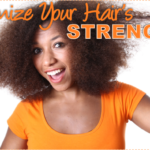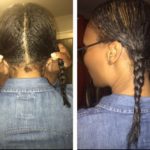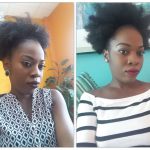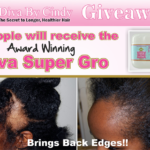 5. Avoid heat – It might be tempting to straighten your hair so that you can match both textures but avoiding heat will prevent a lot of the breakage associated with over-processed relaxed hair and allow for the protein treatments to do their job at mending the damage.
5. Avoid heat – It might be tempting to straighten your hair so that you can match both textures but avoiding heat will prevent a lot of the breakage associated with over-processed relaxed hair and allow for the protein treatments to do their job at mending the damage.
The weakest part of your hair, near the line of demarcation should be protected from breakage and adding heat will only exacerbate any damage that may occur through manipulation. After all, who wants to transition into heat damaged hair?
6. Deep condition regularly – Deep conditioning helps to maintain the moisture levels in the hair and is just great for overall hair health. Deep conditioning* can be done over night or for as little as 15 minutes depending on the product and the needs of your hair.
Hair steaming can be an awesome treat for transitioning hair, if you decide to invest in a steamer* add essential oils* as this will help you relax as you keep your hair healthy.
7. Wash hair in sections – This is the best advice any natural could receive and is great for transitioners to practice for when that thick lush natural hair begins to form the majority of your tresses.
A smaller section means easier detangling and makes application of product thorough and complete. Determine how many sections are best for you, four or eight whatever works!
8. Co-wash and try a sulfate free shampoo* – Co washing does not strip the hair of its natural oils* and is a quick way to add moisture to your hair when you don’t have the time to invest in a full wash.
Using a sulfate free shampoo cleanses the hair without stripping it and can be very beneficial to the health of your hair. Determine how often you would like to co-wash and how often you need to shampoo, some opt for weekly shampoo regimens, others do it monthly. It depends on your hair and it’s needs.
Bonus Tip
9. Use the right products – Made for purpose black hair products that help in your transition are also pretty popular these days. From detanglers that help you deal with both textures easily to products that give your relaxed hair strength to prevent excess breakage while styling.
There are even entire transitioning kits that help cleanse and hydrate both textures and take a lot of the guesswork out of your new hair journey. Just do your research and I’m sure that your transition will be a breeze!
Further reading on transitioning to natural:
Transitioning 101 – A Complete Guide To Switching From Relaxer To Natural Hair Part 1
Transitioning 101 – A Complete Guide To Switching From Relaxer To Natural Hair Part 2
Transitioning From Relaxed To Natural Hair
Why So Many Fail In Their Transition To Natural














#Blue Ivy, lls im just being silly, its cute darlin
Katrina Brown
Stephanie
Sandy Vava Ferrus
Decided to transition this year my last relaxer was in July I believe. Thanks for the tips
There’s nothing more beautiful than to use your 100% natural hair. It’s hard to take care but it will worth the stress, work and suffering. 🙂
What canI use to make my edges grow back and I also have a spot in th back amd on top.
cut it and do it the hard way…
How can I tell what is my hair type?
Precious.